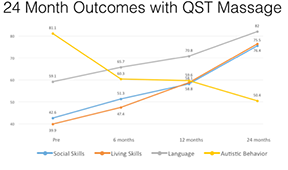More about the Cause and Treatment of Tactile Problems in Autism: Parts 1 and 2
April 20, 2016

|
To further our understanding of abnormal touch/pain responses in children with autism, our group undertook to obtain the first skin biopsies ever reported in autism.* Four children between the ages of 8 and 11 participated in our exploratory study. Biopsies were submitted for specialized evaluation of C-tactile fibers - small tactile nerves mediating pleasant touch, pain, and temperature. Remarkably, results in all four children showed 50% loss of small tactile nerves. This was not a large enough group to be able to explain tactile abnormalities in all children with autism. However, with these four children, results provided an explanation for difficulties with gentle touch involved in daily living, abnormal pain thresholds, and social delay on the basis of tactile loss. Results will be published in the Journal of Neurological Disorders next month [1]. A larger case control study has been initiated.
For part two of this report, we report on results from the two-year follow-up study of children who participated in our randomized control trial (RCT) directed at treating tactile abnormalities using a daily parent-delivered tactile stimulation protocol known as QST massage for autism. The five-month study involved 103 pre-school children with ASD, and replicated the results of earlier RCTs: 50% improvement of tactile abnormalities, 33% improvement in autistic behavior, and 12% decrease of severity of autism [2].
In the longer-term observational study, we wanted to know whether, if children received longer-term treatment, it was possible for tactile abnormalities to resolve completely and for more children to drop into the non-autistic range. After completion of the RCT, children were invited into the observational arm of the study. Parents were asked to continue the daily massage, and children were evaluated at one and two years from start; 67 children completed one year of treatment, 31 completed two years. Results showed that continued treatment resulted in continued improvement. A large number of children fully normalized tactile responses By the end of two years, 1 in 4 children scored in the normal range of the Child Autism Rating Scale. Overall outcomes on autistic behavior, social, language and living skills are shown in the graph above.
* No funds from the Maternal and Child Health Bureau were used for the biopsies.
The randomized, controlled trial and follow-along studies were supported by grant R40 MC 24945 from the Maternal and Child Health Research Program, Maternal and Child Health Bureau, Health Resources and Services Administration, Department of Health and Human Services.
References:
1. L. Silva & M. Schalock. First skin biopsy reports in children with autism show loss of C-tactile fibers. Journal of Neurological Disorders (in press)
2. L. Silva, M. Schalock, K. Gabrielsen, S. Budden, M. Buenrostro, and G. Horton, "Early
intervention with a parent-delivered massage protocol directed at tactile abnormalities
decreases severity of autism and improves child-to-parent interactions: A replication study,"
Autism Research and Treatment, Article ID 904585, 16 pages, 2015.







